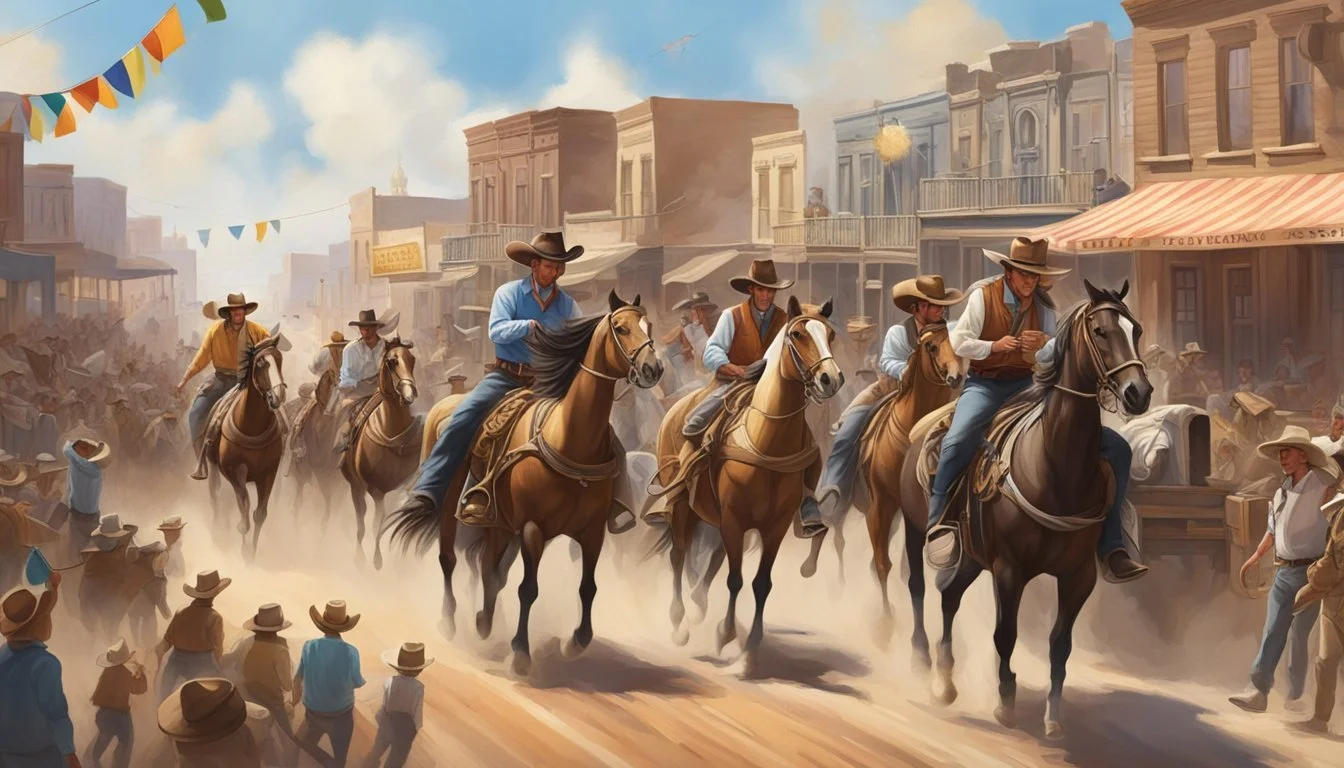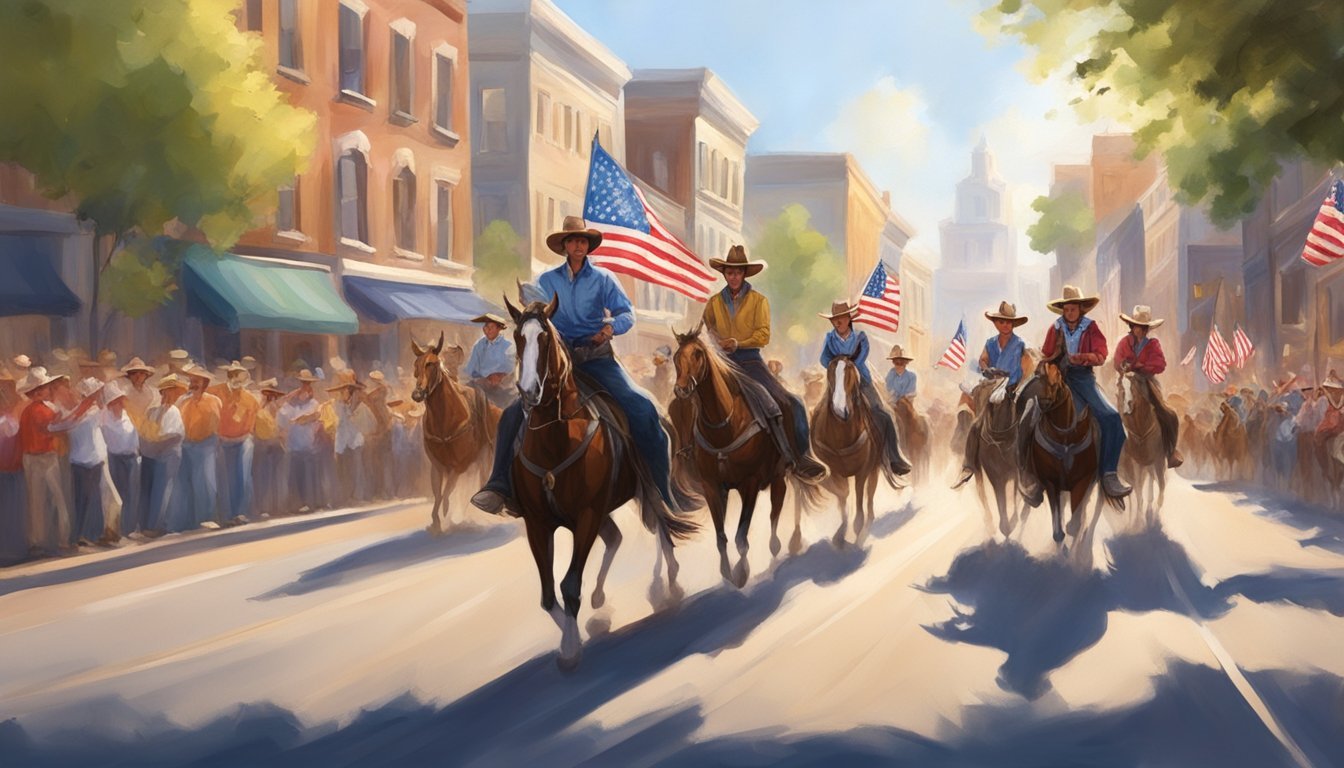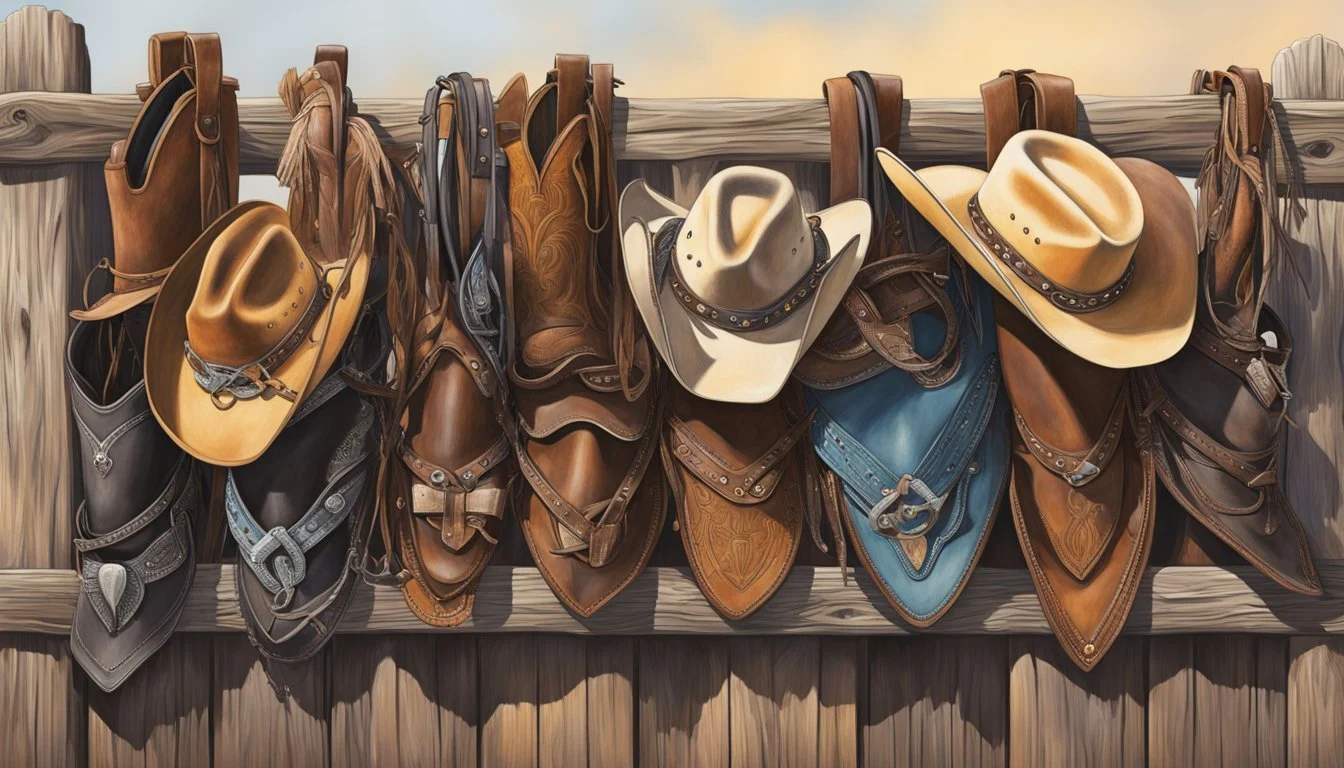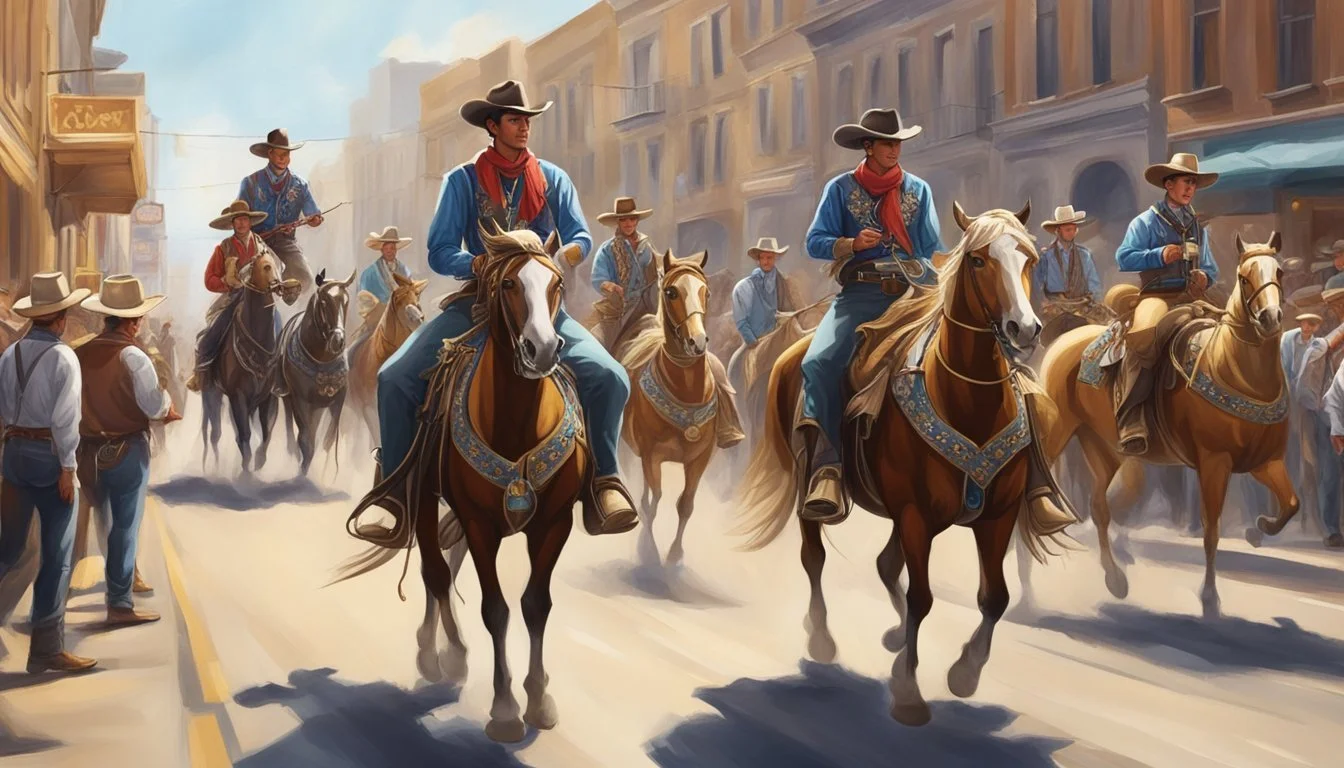The Texas Cowboy's Guide to the Best Western Themed Parades
A Rundown of Must-See Celebrations
The Texas cowboy is an emblem of American heritage, a symbol of resilience and the spirit of the Wild West. This iconic figure, with roots deeply embedded in Texas culture, continues to capture the imagination of people fascinated by the tales of cowboys and the frontier lifestyle. Annual parades across the state pay homage to this legacy, offering a vibrant tableau of cowboy culture in a celebratory setting.
These festive occasions are a window into the past, where the nostalgia of the Old West is brought to life through a blend of history and fanfare. Towns throughout Texas, such as Bandera, often referred to as the "Cowboy Capital of the World," host parades and events that attract visitors keen on experiencing the enduring cowboy traditions. From storytelling and poetry to chuck wagon cook-offs and horse-handling demonstrations, these events preserve and showcase the unique customs of the Texas cowboy.
The best western-themed parades not only provide entertainment but also serve to educate and immerse attendees in the authentic aspects of cowboy culture. As vibrant expressions of this storied past, they maintain a connection to the time-honored practices and values of the American West, ensuring that the cowboy spirit continues to be celebrated for generations to come.
History and Evolution of Texas Cowboy Culture
The Texas cowboy culture is a tapestry of historical influences and evolving traditions that have shaped the Lone Star State's distinct identity. This section delves into the cultural roots of Texan cowboy heritage, the transformation of the rodeo, and the Spanish vaqueros' lasting influence.
The Roots of Texan Identity
The image of the Texan cowboy is synonymous with the state's heritage. The cowboy lifestyle began with the vaqueros, skilled horsemen from Spain who introduced cattle-handling techniques in the 1700s. As the cattle industry grew, these methods became integral to the Texas economy and identity, paving the way for the cowboy's iconic role in American mythology.
Vaquero Influence: Spanish horsemen brought herding expertise.
Cattle Industry Rise: Cattle drives were crucial in the economic development.
Cultural Significance: Cowboys became emblems of Texan pride and resilience.
Transformation of the Rodeo
The rodeo originated as a competitive extension of the cowboy's daily tasks. Initially informal gatherings, the events evolved into structured competitions, celebrating skills like roping and riding. They became a spectacle of cowboy life, pivotal in perpetuating the traditions and skills across generations.
Originally: Rodeos were informal competitions.
Evolution: These events formalized into showcases of cowboy skills.
Cultural Impact: They preserve and celebrate cowboy tradition.
Influence of the Vaqueros
The vaqueros left an indelible mark on the Texas cowboy culture, not only in their expertise with cattle but also in attire, language, and customs. The iconic cowboy image, from the Stetson hat to the lasso skills, has roots in vaquero tradition, representing a blend of Anglo and Hispanic heritages.
Attire and Gear: Influences include the Stetson hat and spurs.
Ranching Techniques: Herding and horsemanship skills were taught by vaqueros.
Language: Cowboy jargon carries Spanish influences, like the word "rodeo."
With each iteration of a parade float that passes, resplendent in Western motifs, one witnesses a living tableau of the Texas cowboy heritage—a legacy nurtured from vaquero roots, memorialized in rodeo arenas, and celebrated in the enduring spirit of the American cowboy.
Iconic Texas Rodeos and Festivals
The Texas cowboy heritage is vibrantly celebrated with a series of iconic rodeos and festivals. These events offer a genuine experience of rodeo competitions, Western culture, and entertainment for all ages.
Fort Worth Stock Show & Rodeo
Fort Worth is home to the Fort Worth Stock Show & Rodeo, an event steeped in tradition since its inception in 1896. Held at the Will Rogers Memorial Center, the rodeo spans 23 days and features a range of events including livestock shows, live music, and a carnival. Fort Worth prides itself as a city that showcases the true spirit of the West through this festival.
Dates: Runs from mid-January to early February.
Activities: Includes professional rodeo events, exhibits, and educational programs.
San Antonio Stock Show & Rodeo
The San Antonio Stock Show & Rodeo takes place in San Antonio and offers more than just a rodeo experience. This event is a staple of San Antonio's February calendar and is known for its high-stakes competitions which are qualifiers for the Professional Rodeo Cowboys Association.
Venue: AT&T Center & Freeman Coliseum fairgrounds.
Features: Agricultural education, scholarships, and live entertainment.
Tejas Rodeo Company Events
Tejas Rodeo Company in San Antonio provides a year-round rodeo experience with a more personal atmosphere. The events showcase both the heritage and the contemporary cowboy lifestyle. Competitions, live music, and savory Texan cuisine are part of the Tejas Rodeo Company's offerings.
Schedule: Saturday nights from March to November.
Highlights: Traditional rodeo competitions, dining options, and dance halls.
Cowboy Arts and Crafts
The Texas cowboy's dedication to their craft is evident through the intricate arts and crafts associated with their daily lives. From sculpting practical yet ornamental barbed wire to shaping the classic silhouette of cowboy hats, each craft bears witness to a rich heritage and skilled artisanship.
Barbed Wire Crafting
Crafting with barbed wire is a revered practice that transforms a functional material into decorative pieces for festivities. Artisans coil and twist barbed wire into intricate designs, creating gifts and decorations that pay homage to cowboy culture. These handcrafted items often feature in parades, showcasing a blend of utility and beauty inherent in cowboy life.
Leatherwork and Saddlery
Leatherwork is central to cowboy arts, with saddlery being a standout discipline. Expert saddle makers merge functionality with ornate designs, producing saddles that are both durable and aesthetically pleasing.
Materials: Leather, metal hardware
Products: Saddles, belts, holsters
Leatherwork reflects a cowboy's personal style and often becomes a cherished gift.
Cowboy Hat Shaping
Cowboy hat shaping is an art that balances the hat's functional purpose with its identity as a western icon.
Steps to shape a cowboy hat:
Steam the fabric to soften.
Mold the crown and brim to desired contours.
Allow it to cool and set into shape.
Hatters apply their expertise to ensure each hat offers protection from the elements while exhibiting the individuality of the wearer.
Music and Dance of the West
In the cowboy lifestyle, music and dance are not just entertainment; they're a part of tradition and community cohesion. These cultural artifacts resonate the spirit of the West through their unique styles and social significance.
Country Music's Role in Cowboy Life
Country music has historically been the heartbeat of cowboy life. It reflects the joys, struggles, and stories of those who live and work in the vast landscapes of the West. Artists like Gene Autry and Roy Rogers became icons by infusing their music with the essence of cowboy culture, which often included narratives of cattle drives, the solitude of the range, and the camaraderie among ranchers.
Significant influences: Western swing, a subgenre, drew from diverse sources including European immigrant and African American music styles.
Legacy: Modern country artists continue to honor these traditions while also incorporating contemporary elements.
Line Dancing and Community Gatherings
Community gatherings, such as winter dances in West Texas, were pivotal for social interaction among cowboys and ranchers. Line dancing, with its structured patterns and group participation, exemplifies this communal aspect. Ranch dances have a rich history dating back to the late 1800s when they provided a welcome break from ranching duties.
Traditional events: The Texas Cowboys' Christmas Ball in Anson, Texas, continues a dance tradition that started in 1885.
Dance style: Line dancing's hallmark is synchronized movement in rows, which encourages unity and allows for wide participation.
Ranching and Cattle Drives
The Texas cowboy tradition is rooted deeply in the practices of ranching and cattle drives, which are pivotal to the state's history and economy. From the historical significance of King Ranch to the open range challenges faced by cowboys, this section explores both the historical and contemporary aspects of cattle ranching.
King Ranch Legacy
King Ranch in Kingsville stands as a monumental entity in Texas ranching history. Established in 1853, it spans over 825,000 acres, making it a colossal figure in the cattle industry. The ranch is not only a testament to the evolution of ranching practices but also serves as an educational resource for understanding the cattle business, offering tours that highlight its extensive cattle-breeding programs and commitment to land stewardship.
Open Range Challenges
In the era of the open range, the roundup was a critical event that demonstrated a cowboy's skills. Without any enclosed pastures, cattle roamed freely, and cowhands had to locate and herd their scattered livestock. This process was both labor-intensive and required a profound knowledge of the landscape and cattle behavior. The challenges of weather, rustling, and navigating vast expanses of land were omnipresent threats to the success of these drives.
Contemporary Cattle Ranching
Modern-day ranches have evolved significantly from their historical predecessors. Cutting-edge technology and science have transformed cattle ranching into a sophisticated industry. Genetic research, precise feeding programs often involving corn to bolster beef production, and land management practices exemplify the proactive steps taken by contemporary ranchers to maintain both cattle health and ecosystem balance. Despite mechanization and modernization, the spirit of the cowboy endures in the day-to-day operations and the cultural identity they preserve.
Cowboy and Cowgirl Lifestyle
The cowboy and cowgirl lifestyle is defined by the practical activities of managing ranches and the mastery of horseback riding, both of which require skill, dedication, and a strong connection to family and tradition.
Day-to-Day Ranch Activities
Cowboys and cowgirls begin their day early, often before sunrise. Their day-to-day activities center around the care and management of livestock, particularly cattle. Tasks include:
Feeding: Ensuring all animals have access to appropriate feed and water.
Maintenance: Repairing fences, checking on the health of the herd, and maintaining ranch equipment.
Training: Teaching younger animals to become accustomed to human interaction and preparing them for the tasks they'll perform as part of the herd.
This lifestyle is deeply rooted in family, as many ranches have been passed down through generations, making the work a family affair.
Horseback Riding and Horsemanship
Horseback riding is not only recreational; it is an essential skill for effective ranch management. Cowboys and cowgirls spend a considerable amount of time:
Training Horses: Teaching horses to respond to commands and to work with cattle.
Riding Techniques: Mastering different riding styles according to the needs of the day's work.
Cowgirls are as adept as their male counterparts, with many excelling in the fine nuances of horsemanship, fostering an adorable bond with their horses. Horseback riding is a cornerstone of the cowboy life, reflecting competence and a deep respect for these powerful animals.
Education and Preservation
In the Lone Star State, the commitment to educating the public on cowboy heritage is manifested in museums and academic institutions. These establishments strive to preserve the unique culture through interactive exhibits and focused studies.
The Witte Museum Experience
The Witte Museum in San Antonio stands as a bastion of Texas history and culture. It offers interactive exhibits that allow visitors to engage with the cowboy legacy firsthand. From historical artifacts to multimedia presentations, the museum's vast collection emphasizes the significance of cowboys in Texas's narrative.
Cowboy Culture Studies in Lone Star Academia
Higher education institutions across Texas are incorporating cowboy culture into their curriculum. These studies offer a comprehensive look at the historical and sociological impact of cowboys in the state. Scholars and students analyze texts, participate in discussions, and conduct field research, often engaging with local communities to preserve the living history of the Texas cowboy.
Western-Themed Parades and Activities
Texas is renowned for its vibrant Western-themed parades and activities that attract families and enthusiasts to relive the Old West's charm. These events celebrate the state's rich cattle ranching heritage through engaging activities such as cattle drives, set against the backdrop of some of its most iconic locations.
San Antonio River Walk Events
San Antonio's River Walk is home to numerous annual events that embody the Western spirit. The River Walk holds special parades where locals and tourists alike can experience the storied cowboy culture. One can witness floats that traverse the winding waterways adorned with Western themes, enjoy live country music, and watch as the area transforms into a festive celebration of Texas heritage.
Annual Events Include:
Western-themed boat parades
Musical performances on the Arneson River Theatre stage
Family-friendly interactive activities
Dallas Pioneer Plaza Celebration
Dallas's Pioneer Plaza provides a unique glimpse into the cowboy era with its large-scale bronze sculptures of a cattle drive, serving as the centerpiece for celebrations. During special events, the plaza buzzes with activity, inviting visitors to partake in the reenactment of historical moments.
Activities at Pioneer Plaza:
Historical reenactments
Bronze sculpture viewing
Educational tours for all ages
Visitors attending these events are encouraged to engage with the attractions and learn about Texas's storied past through immersive experiences that honor the Cowboys' way of life.
Guide to Planning Your Parade Experience
Planning a trip to a Western-themed parade in Texas mandates a well-thought-out approach to maximize the experience. Understanding which events to choose and how to enjoy them with family are crucial steps.
Selecting the Right Events
When considering Western-themed parades and cowboy experiences, individuals and their families should look for events with rich historical significance and entertaining activities. One such event is the Western Heritage Parade in downtown San Antonio, renowned for its celebration of Texas and Old West heritage, managed by the San Antonio Riverwalk. It is advisable to check the parade's schedule in advance, as it offers an opportune setting to experience Western tradition.
Event Selection Checklist:
Historical significance
Family-friendliness
Ease of access
Schedule of events
Opportunity for interaction
By selecting events that offer both educational and entertainment value, families can ensure a more enriching experience.
Tips for Enjoying the Parade with Family
Attending a parade with family requires some additional consideration to ensure everyone has an enjoyable and stress-free time.
Arrive Early: For the best views and to secure a spot, aim to arrive at least an hour before the parade begins.
Pack Essentials: Bring water, snacks, sunscreen, and hats to keep comfortable during the event.
Engage with Performers: Encourage children to interact with the performers when appropriate, as many cowboy-themed events have performers who are more than happy to engage with the audience.
Family Comfort Tips:
Seating: Consider portable chairs or blankets for seating.
Safety: Keep an eye on young children at all times and identify meeting points in case someone gets lost.
Attire: Dress in comfortable clothes, and in the spirit of the event, why not don cowboy hats for an added touch?
By carefully planning the parade visit and prioritizing comfort, one can prevent most mishaps and ensure that the focus remains on the engaging cowboy experience.






